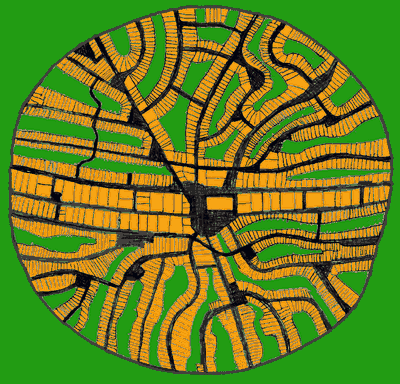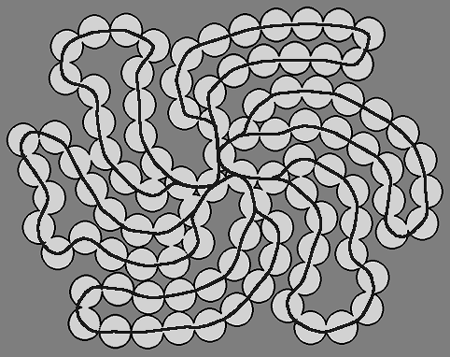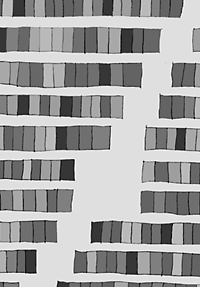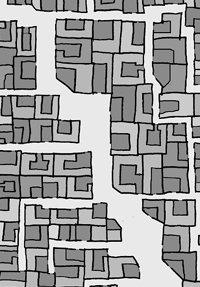|
|
|
Volume 1, Number 1 |
Published by Crawford Systems |
Winter 1997 |
|
Premier Issue of Car-Free TimesWelcome to the first issue of Car-Free Times! The newsletter is published quarterly by Crawford Systems and distributed in cooperation with Future Trends International (Group) Corporation (FTI). Each issue will be devoted to news and information about the development of sustainable, ecologically-sound cities based on extensive use of public transport for both passengers and freight. While the focus is on neighborhoods and cities that are completely car-free, we will also review developments in cities taking a structural approach to reducing car and truck usage while maintaining excellent mobility and improving the environment. The last few years have seen a dramatic increase in concerns about the various types of pollution and social damaged caused by automobiles. We have seen the dawning of an awareness of the true costs of intensive car and truck usage. To become a charter subscriber, please see the last page of this issue for various subscription possibilities.

World News Notes & CommentEach issue includes a section covering events related to the urban automobile in countries around the world. If you know of interesting developments, please pass them along for inclusion in the next issue.
Fewer Cars in AmsterdamIn a 1992 referendum, Amsterdam citizens approved a dramatic reduction in the number of cars in the inner city. Support for the referendum was highest among residents of the inner city, who are acutely aware of the day-to-day costs of heavy automobile traffic. Plans were made to implement this decision by reducing parking spaces in the inner city by 50% before the year 2002. Adapted from: Platform Binnenstad Autovrij
Air Pollution in DelhiWinter in Delhi, once a sunny season, is now an eye- watering fog of pollution. Breathing the air in the city's central core is equivalent to smoking 20 cigarettes a day. In the evening rush hour, 1.2 million basic two-wheel scooters weave among diesel-powered buses and heavy trucks. Overhead, billboards warn motorists to consider pollution masks. Like other megacities around the world, urban "progress" in Delhi has its price. The World Health Organization says the city's air quality may soon be the world's worst. A recent WHO report indicated that motor vehicles are turning metropolises such as Beijing, Manila, Bangkok, and Bombay into environmental time bombs. The total number of vehicles in the world is expected to double to about 1.2 billion in 20 to 30 years, with most of the expansion coming in Eastern Europe and Southeast Asia. Adapted from Toronto Globe and Mail, 16 Feb. 1993, as reported by: Auto-Free Zone, April-June 1993, vol. 1, nr. 3, published quarterly by: Auto-Free Ottawa. Clearly, as standards of living rise, people expect better mobility. Until now, this has been provided by the automobile and two-stroke (oil-burning) scooters, which carry high environmental costs. However, with proper planning, car-free cities can offer even better mobility at lower economic, social, and ecological costs.
Rebuilding Existing City Cores in the U.S.A.There is increasing interest in rebuilding existing urban areas instead of expanding into adjacent rural areas, especially in places where population growth is low. Instead of occupying agricultural land, existing unused and under-utilized parcels within the city are rebuilt to meet current needs. This is cheaper, more energy efficient, and leads to a more compact city surrounded by green space. Attention is also paid to safety and social values. The resulting city is much better suited to public transport than the large, sprawling cities typical of North America. Dense city cores also give a real feeling of "place." More information: Environmental Building News
Energy-Efficient Land Use in CanadaPolicies for energy-efficient land use have been identified as follows: selective densification; growth management; residential intensification; transit-oriented developments; and conservation land trusts. Additional tools for traffic reduction are: road pricing strategies; new approaches to transportation analysis; trip reduction bylaws; free or inexpensive transit; traffic calming; traffic cells; and transit marketing. Source: Auto-Free Zone, vol. 1, nr. 3, referring to: Towards Sustainable Communities: A Resource Book for Municipal and Local Governments, Mark Roseland. The sustainable development movement has identified a number of land-use policies necessary to reduce the burden on the environment. These policies are entirely consistent with the car-free concept and many are an integral part of the design. One of the advantages of the car-free city is that it makes room available for green space which can be used for conservation, and land trusts offer an excellent means to assure that green space stays green.
Carbon Dioxide in the EUCarbon dioxide emissions from vehicles will continue to rise in the European Union until the end of the century, even though the EU target is to hold year-2000 emissions to 1990 levels. (EU White Paper on transport policy, December 1992.) The White Paper contends that if current trends continue, carbon dioxide emissions from the transport sector will rise by 24% between 1990 and 2000. Technical measures to improve fuel efficiency will not be sufficient to stabilize CO2 emissions. Even a 40% increase in fuel efficiency of passenger cars by the year 2005 is insufficient to stabilize CO2 production by 2010. Source: New Scientist, 2 Jan 1993 Worldwide CO2 output continues to increase, and with it concerns about global warming and coastal flooding. While all energy use needs to become more efficient (and ideally renewable), transport is one sector where growth is very high. Some more energy-efficient form of transport needs to replace the automobile. We need look no farther than rail vehicles for a solution. The rolling friction of steel wheels on steel rails is very low, and trains have low aerodynamic drag. Add regenerative braking and you have a means of trans- port that is energy efficient and ready for use with any renewable energy source which can produce electricity. Trams, metros, and intercity trains all provide transport at low per-seat-mile energy costs. Of course, compact, dense cities reduce the distances that must be traveled, still further reducing energy consumption and CO2 output.
Road Salt in CanadaHalf the salt dumped on icy roads in winter ends up in ground water, and could eventually make it unpleasant and even unhealthy to drink. Salt is not washed away by spring rains and melting snow as had always been assumed, but accumulates underground. Only about 45 per cent of the previous winter's salt is washed downstream; the rest remains in the ground water. Source: New Scientist, 12 Dec. 1992 Any transportation system that is the basis for daily economic activity must be available for use at all times. This can only be achieved in northern climates by plowing, sanding, and salting roads, with the result that huge amounts of salt are being applied to roads, especially in North America. Rail-based transportation is largely immune to weather-related delays, and salt is never used.
Air Pollution Harms 50% Of CanadiansMore than half of all Canadians are exposed in summer to unhealthy levels of smog, which is caused mainly by automobile exhaust. Automobile traffic is increasing faster than improvements in emission controls, and levels of ozone have not improved in Ontario during the past 10 years. In addition, automobile exhaust gasses contain significant amounts of benzene, a cancer-causing agent. Source: Toronto Star, 26 Nov 1992 Almost anything that helps to reduce gasoline consumption helps in the fight against all forms of air pollution.
Car-Sharing Works in BerlinStattauto is one of a number of successful car-sharing organizations in Europe.Berlin is one of 49 cities in Germany, Switzerland, and Austria where cars are shared. Stattauto in Berlin has 57 vehicles shared by 800 users. Each user has a magnetized plastic card to open a safe, placed near each car's parking spot, that contains car keys and registration documents. (The card doubles as a ticket on the Berlin public transport system and can also be used to pay for taxis, so all urban transport needs are met by a single card.) Problems have been few. In Berlin, only once has a member taken a car without booking it. Only about once a week does someone not get the car they want exactly when they want it. For more information on car sharing, write to: Stattauto, Manteuffelstrasse 40, D-1000 Berlin 36, Germany, tel. +49 30 611 35 27. Adapted from In Context, Winter 1993 Car-sharing is well suited to the cities with low auto usage. Peripheral garages are ideal locations for car-sharing facilities for those who occasionally need a car to travel outside the city. Advantages of car-sharing: low capital and operating costs; less space required for parking.
Miscellaneous Facts About Cars in the U.S.A.
Source: Department of Transportation, Bureau of Transportation Statistics As people become better acquainted with the direct and hidden costs of the automobile, there is increasing interest in other solutions. The result is more interest in car-free alternatives.
A Design for Car-Free Cities

IntroductionCrawford Systems has been working for nearly a decade to develop a practical, economical design concept for car-free cities. A brochure is available describing a standard reference design for car-free cities. Please request a copy if your would like more information on this design. This document is also available in printed form, for details e-mail us.
City Design Requirements and the Car-Free CityAll healthy cities meet three basic needs of both residents and businesses:
These basic needs give rise to several fundamental design requirements which form the basis for the design of car-free cities:
These are challenging requirements but can be met by the design now under consideration. The resulting city is energy-efficient, causes minimal pollution, has plenty of space available for productive use, and provides a high quality of life for its residents.

Some Variations on the LayoutThe basic design for the car-free city is highly flexible. For instance, it is possible to make the city much denser than achieved by the reference design. The lobes are simply twisted tightly around the center core as shown above. |
|
|
|
|
Wide variety in neighborhood design is possible. Two variants are illustrated below. The only important criterion is that the density needs to be fairly high. A Floor Area Ratio (FAR) of about 1.5 needs to be achieved in order to house a large population and to provide fast transport. This means that 1.5 square meters of floor space must be built for every square meter of ground. High density is the key to all successful public transport systems, but this can be achieved in a city that provides a very high quality of life and does not feel overcrowded.
Trams or Metro?The reference design presumes the use of an underground metro system to provide all transport. However, another method, the use of street-level trams, is under consideration because of the large cost reductions this allows. Preliminary investigation indicates that a tram system can carry nearly as many people as a metro because trams can be run with shorter headways than metros. Thus, even though trams are shorter (two, three, or four trams coupled together instead of trains up to 12 cars long), the increased frequency of operation provides high capacity. The use of trams for freight transport requires more study but appears to be feasible. Because a tram system is so much cheaper to build than a metro, it is well suited to testing the car-free concept. Of course, the tram has some significant disadvantages:
Trams are, however, very pleasant for the passengers, who get an interesting view of the city. The maximum operating speed of a tram is lower than for a metro, but the shorter headways make up for some of this loss; it is still possible to go door-to-door between the two most distant locations in about 45 minutes in a city of one million. Because of the low capital costs, a trial using trams is worth pursuing.
Shanghai ConferenceThe Shanghai International Communication on Residential Design '96 began on 3 November 1996 and ran through 6 November. About 500 persons attended the conference, with more than 100 visitors from outside China. The conference was a great success, with many important new ideas receiving attention and discussion. The organizers have reason to be proud of this accomplishment. The Shanghai city government wants to improve the quality of housing. While the government's goal of providing about 11 square meters per person may sound modest, it would be a considerable improvement on the current situation, and Shanghai will build 10 million square meters of new housing every year for the next several years in order to achieve this goal. This is a phenomenal undertaking and Shanghai is asking for foreign help with specific phases of the design work. The conference was coupled with a design competition, and hundreds of entries were received. Contestants were asked to design an ideal residential neighborhood for the 21st Century. Most of the plans submitted made use of at least three different housing types: low-rise, mid-rise, and high-rise. The judges had difficulty choosing the best plans. This was my first trip to China, and I have summarized my impressions of Shanghai and the conference below. Shanghai is a city of 13 million inhabitants crowded into a relatively small land area at the mouth of the Hangpu River. It is a major port. The entire city is one huge construction site, with more than 21,000 project under way. It is likely that ground is broken for a new skyscraper more frequently in Shanghai today than at any place and time in history. The pace of change is difficult to comprehend. The architectural styles comprise a highly eclectic mix that is generally interesting. This is a bustling, vibrant city thronging with people. Although road traffic is still relatively light, it is increasing steadily. Air pollution is already a serious concern. A metro has recently been completed and is already being extended. One recurrent theme during the conference was the sorrow about the loss of the traditional Shanghai lilong housing. This pattern of housing provided a very high quality of life for the residents despite the high concentration of people in small areas. A typical lilong neighborhood is arranged with long rows of houses oriented east-west, so that the front doors can face south, which is considered important and provides better solar access in the winter. The alleys onto which the buildings front are only 4 to 5 meters wide. The houses themselves are typically 12 meters deep and between 2 and 4 stories high. This yields an FAR of slightly above 2.0, which is quite high. Everyone with experience in these neighborhoods was impressed by the high quality of life despite the crowding. The level of community is high and the neighbors are always close at hand. The alleys serve as a sort of outdoor living area where a great deal of socialization goes on. Small family businesses are sometimes found on the ground floor. Unfortunately, this form of housing, unique to Shanghai, is quickly passing. In order to provide modern accommodations and more living space for each inhabitant, it is thought necessary to build mid- and high-rise buildings. Everyone agrees that this means the end of the lilong communities, which are being demolished to make room for high-rise buildings. The loss is regretted by all. Shanghai has embarked on a massive program of road construction. Some of the new elevated highways are already complete and have been built to international standards. While the traffic on these highways is still relatively light most of the time, it is undoubtedly increasing rapidly with the rising standard of living and the increasing ownership of private automobiles.
Cooperation with FTIMany valuable contacts were made at the Shanghai conference. In particular, Crawford Systems will be working closely with Future Trends International, originators of the Shanghai conference, to bring car-free cities to China. A city is being sought that would be interested in being the first in the world to build a large car-free addition. We will keep you informed of progress.
Subscribe to Car-Free TimesBe sure not to miss an issue by subscribing now. Subscriptions to the printed version cost US$ 10.00 for one year (four issues). Send a North American bank check for US$ 10.00 or a Eurocheque for NLG 19.00 payable to J. Crawford. Car-Free Times is also published on the Crawford Systems World Wide Web site. We can send you e-mail notification of each new issue. Please send e-mail to subscribe; no subject or text is necessary. You will receive automatic e-mail notification of each new issue, with the URL for the new issue. The electronic edition is distributed free of charge.
Contact Information |

